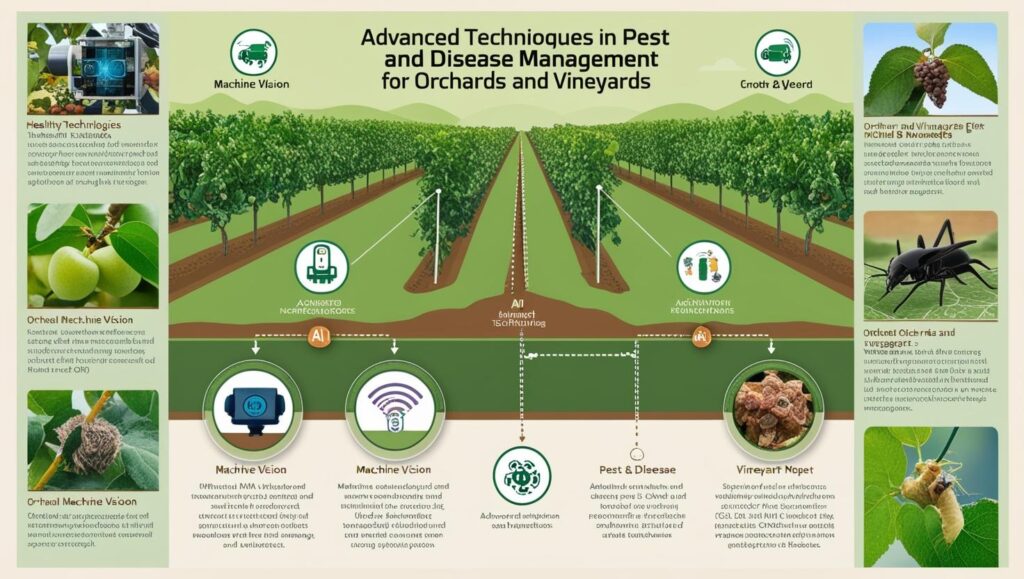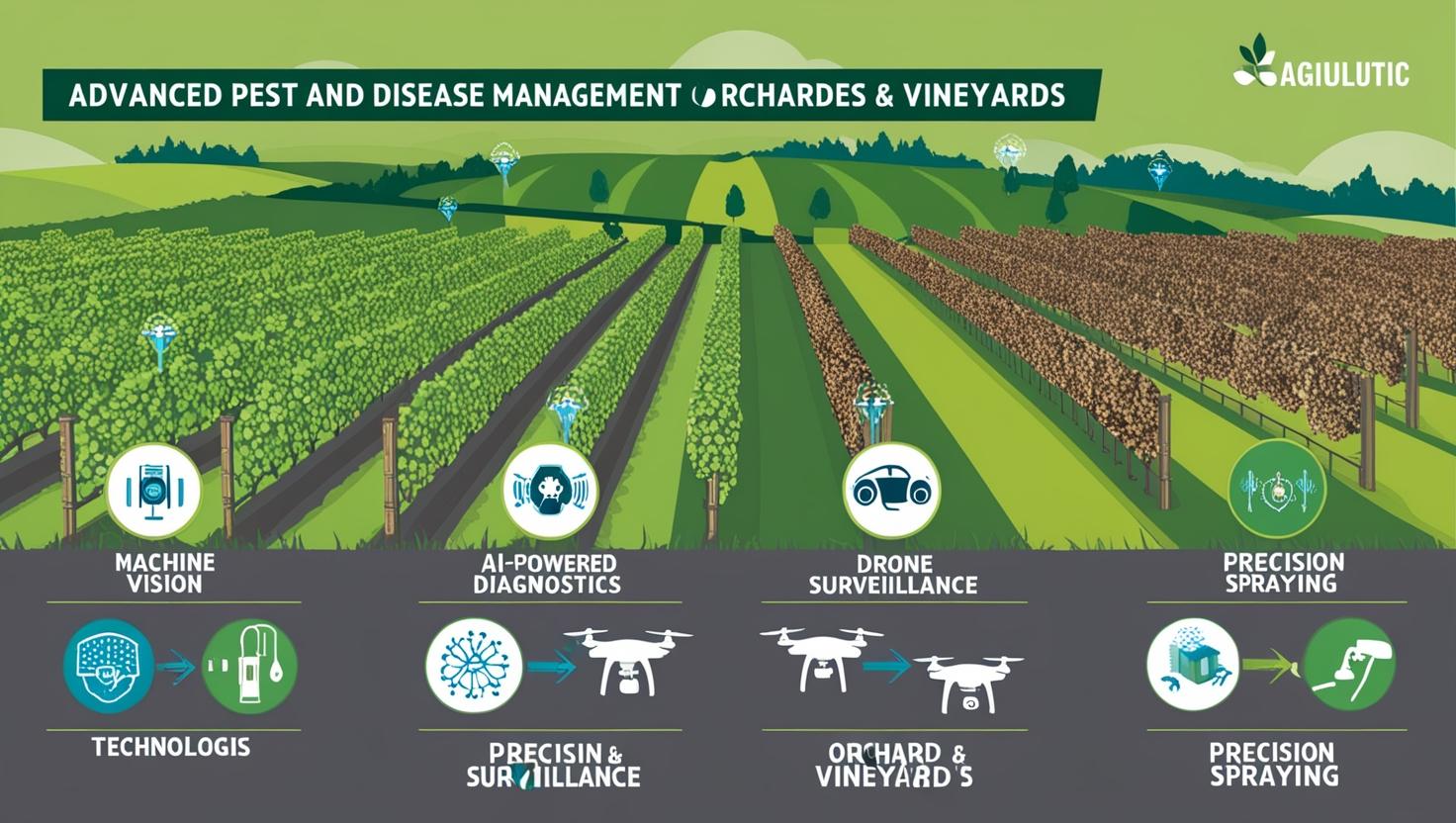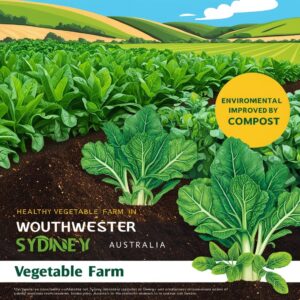In the fast-evolving world of agriculture, managing pests and diseases is no longer about traditional methods alone. Today’s orchards and vineyards rely on a suite of advanced technologies—from machine vision to AI—to keep crops healthy and yields high. This article takes you through some of the cutting-edge techniques available for monitoring and controlling pests and diseases in crops, with actionable tips to help growers navigate these innovative solutions.
1. Sensing and Actuation Technologies in Pest Management
Sensing and actuation technologies play a critical role in early pest detection and management, which can ultimately lead to increased yields. Here’s a look at some of the most effective methods:

- Machine Vision & Imaging: Using high-tech cameras, such as multispectral and hyperspectral imaging, machine vision can identify insect species with impressive accuracy. For example, studies have shown an 87% correct classification rate for eight insect species using geometry and color features. Actionable Tip: Set up multispectral cameras in your vineyard to monitor for pest infestations early and prevent further spread.
- Trapping: Trapping technology has advanced with innovations like pheromone traps and camera-supported probes for soil microarthropods. A camera-based trapping probe can now detect pests such as mites and beetles with a 60-70% success rate. Actionable Tip: Use pheromone traps to lure and monitor insect activity, adjusting your pest management tactics based on real-time data.
- Data Mining: With weather conditions often influencing pest behavior, data mining helps predict pest outbreaks. Wireless sensor networks can track pest activity, helping farmers adjust their approach based on environmental triggers. Actionable Tip: Install sensors that link with data mining software to adjust your pest management strategies according to seasonal weather changes.
- DNA Analysis: Soil samples now allow for DNA analysis, which can detect specific pests, such as the grape phylloxera, even before symptoms are visible. Actionable Tip: Integrate DNA soil sampling in your routine checks to proactively manage soil-borne pests.
2. Techniques in Disease Detection and Management
Early detection of plant diseases is essential, as it can prevent widespread crop damage. Advanced sensing platforms provide non-invasive solutions to monitor plant health. Here’s how it works:
- Thermography & Spectroscopy: Thermographic and spectroscopic tools detect temperature changes and chemical compositions in plants, identifying stress before visible symptoms appear. Actionable Tip: Use portable spectroscopy devices in the field to spot early signs of infection, allowing for immediate intervention.
- Biosensors & Volatile Organic Compounds (VOCs): Plant biosensors measure VOC emissions, which can signal stress or infection. These indicators can help identify diseases, including symptomless infections. Actionable Tip: Regularly deploy VOC detectors to catch early infection signs, especially in high-risk areas of your orchard.
3. Precision Spraying for Targeted Pest Control
Precision spraying has revolutionized pest control, offering targeted solutions that reduce pesticide use:
- Laser-Based Spraying: By using a laser sensor to detect trunk size, targeted pesticide spraying minimizes waste and reduces environmental impact. Field trials report up to a 91% cost savings. Actionable Tip: Invest in laser-guided spraying systems to optimize pesticide usage based on plant size and density.
- Variable Rate Technology: Utilizing UAVs and LiDAR technology, sprayers can adjust rates based on plant health, canopy size, and soil moisture levels. This approach reduces chemical use by over 20%. Actionable Tip: Set up a variable rate spraying system with UAV assistance to reach different canopy levels without excessive chemical use.
4. Bird Control Solutions in Orchards and Vineyards
Birds can pose significant threats to fruit production, especially in vineyards. Modern solutions focus on autonomous systems:
- UAV-Based Bird Deterrents: UAVs, equipped with cameras and audio, fly around vineyards to scare off birds. Tests show a 50% reduction in bird presence when drones are active. Actionable Tip: Set up a routine drone flight schedule to patrol your vineyard and reduce bird damage to your crops.
- Acoustic Detection and Neural Networks: Some systems use recorded bird sounds and neural networks to detect and respond to pest birds, boasting 89% accuracy. Actionable Tip: Use sound-based bird detection technology to create a deterrent system that automatically identifies and scares away target bird species.
Summary for Instagram Reels and Canva Infographics
- Intro: “Explore the latest pest and disease management techniques transforming vineyards and orchards!”
- Sections:
- Sensing Technologies: Machine vision, imaging, and trapping for early pest detection.
- Disease Detection: Thermography and biosensors for early diagnosis.
- Precision Spraying: Laser and variable rate technology for targeted pest control.
- Bird Control: Autonomous UAVs and acoustic systems to protect crops from birds.
- Conclusion: “Using these innovative tools can help farmers manage pests and diseases sustainably while maximizing yield!”
These advanced techniques offer robust, cost-effective solutions for a more sustainable and productive orchard or vineyard management.
Unlocking the Future of Pest and Disease Management in Orchards and Vineyards
In modern agriculture, where crop health directly influences yield and quality, managing pests and diseases efficiently is more critical than ever. Orchards and vineyards, in particular, face numerous challenges from pests like mites, nematodes, and damaging insects, as well as diseases that can be invisible yet devastating. Emerging technologies are transforming how we detect, diagnose, and manage these issues. By using precision tools, smart devices, and sustainable strategies, farmers and growers are set to improve crop health while minimizing chemical usage. Let’s explore how these innovations are reshaping pest and disease control.
Precision Pest Management: Smart Sensing Technologies
1. Machine Vision and Imaging
One of the most powerful advancements in pest detection is machine vision. By analyzing images with multispectral and hyperspectral technology, specific pest patterns can be detected and managed early. For example, studies have shown that machine vision can achieve up to 92% detection accuracy for pests like grasshoppers and butterflies. These algorithms also allow targeted pesticide applications, which reduces the need for widespread chemical use.
- Actionable Tip: Implement machine vision technology if you’re managing large vineyards; it’s especially useful for detecting common orchard pests like apple maggot and stink bugs.
2. UAVs (Unmanned Aerial Vehicles)
Drones equipped with various cameras and sensors are now commonplace in large vineyards. These UAVs capture real-time, high-resolution images, which allow for targeted pest management by assessing plant health and identifying infestations from above.
- Actionable Tip: Regularly schedule UAV flyovers in peak pest season to maintain up-to-date knowledge of crop conditions and proactively address issues.
3. Nuclear Magnetic Resonance (NMR) and DNA Analysis
For more invasive pests like grapevine phylloxera, technologies such as NMR spectroscopy and DNA analysis offer precision detection methods. These tools detect changes in the plant at a cellular level, providing early indications of infestations that may not be visible otherwise.
- Actionable Tip: Use DNA analysis in high-investment crops where early pest detection can save time and prevent extensive damage.
Disease Detection: Pioneering Techniques in Plant Health
1. Spectroscopy and Thermal Imaging
Tools like spectroscopy and thermography provide insight into plant health by detecting temperature and color changes associated with disease. For instance, chlorophyll fluorescence can reveal stress levels in plants, allowing for early detection of fungal or bacterial infections.
- Actionable Tip: Consider installing thermal cameras for continuous monitoring, especially in larger operations where disease management needs immediate attention.
2. Robotics and Biosensors
With biosensors and robotic platforms, farmers can automate the detection of volatile organic compounds emitted by infected plants. This provides precise, real-time disease monitoring across an entire vineyard or orchard, especially useful for fast-spreading diseases.
- Actionable Tip: Set up biosensors in areas of high traffic or stress to quickly spot infection signs and prevent outbreaks.
Managing Pest Populations Sustainably
1. Trapping and Data Mining
Traditional trapping methods are evolving with technology. Using data mining techniques, traps now provide insights into pest behavior patterns, helping farmers predict infestations based on local weather data and other variables.
- Actionable Tip: Use data mining to refine pest management practices seasonally, aligning actions with pest life cycles for more effective control.
2. Precision Spraying
Precision spraying with technology like LiDAR sensors allows farmers to apply pesticides accurately based on canopy size and density. This approach not only reduces chemical waste but also lessens environmental impact.
- Actionable Tip: Pair precision sprayers with image-based diagnostic systems to cut down on chemical use and ensure pesticides reach their target effectively.
3. Bird Control with UAVs
Bird pests can wreak havoc in vineyards. Using UAVs with sensors and cameras to spot birds and deter them through noise or mild chemical deterrents is an effective solution, reducing crop loss while avoiding invasive bird traps.
- Actionable Tip: Schedule regular drone flyovers during harvest season to minimize crop loss due to bird interference.

Key Takeaways for Infographics or Reels
- Focus on Technology: Explain the value of machine vision, UAVs, and NMR in detecting pests and diseases early.
- Promote Precision: Emphasize the importance of precision spraying and targeted trapping as sustainable pest control methods.
- Sustainable Practices: Highlight robotics and data mining as modern alternatives to traditional pest and disease management.
- Actionable Tips: Share quick, actionable tips on using technology to achieve healthier, more productive crops with minimal waste.
These new technologies promise a future of agriculture that’s smarter, more efficient, and more resilient. By adopting these tools, farmers can protect their crops and ensure sustainability, making a direct impact on yield and profitability. With ongoing research and a push for more accessible technology, the industry is well on its way to a greener, more productive future in pest and disease management.





Key Emerging Technologies in Pest and Disease Management
1. AI and Machine Learning Applications
- AI-driven models like traditional artificial neural networks (ANN) and modern convolutional neural networks (CNN) are used for pest detection and prediction. AlexNet marked the start of the AI boom, leading to models like VGG16 and SSD (Single Shot Multibox Detector) that enhance detection accuracy on sticky traps.
- Studies show SSD outperformed VGG16 in detecting insects, supporting better pest monitoring in high-traffic areas (Nam and Hung, 2018).
- YOLO models (v3 and v1) are used in automated insect detection systems for pests like the Asian citrus psyllid (ACP) with high precision and recall, which are crucial metrics for effective pest detection (Partel et al., 2019).
2. Remote Sensing and Spectroscopy
- Hyperspectral sensors are invaluable for early disease detection, monitoring plant health by capturing subtle physiological changes before visible symptoms emerge.
- Satellite vs. UAV Imaging: A study comparing Sentinel-2 satellite images and UAVs found that both can detect variability across vineyards, especially when no inter-row grass is used (Sozzi et al., 2020).
3. Biosensors and Plant VOCs
- Biosensors: These portable devices detect volatile organic compounds (VOCs) released by infected plants, providing real-time disease diagnostics at the plant level. They are useful for field applications and detecting fungal diseases like Botrytis and Phytophthora.
- Volatile organic compounds (VOCs) analysis helps monitor plant health and predict infections, though current gas chromatography techniques are complex and time-consuming.
4. Smartphone Applications and Robotics
- Smartphone apps utilizing deep neural networks can identify pests, diseases, and nutrient deficiencies with 89% accuracy (Schumann et al., 2020). Though lab diagnostics remain critical, these apps promise rapid field-level diagnostics.
- Companies like Bloomfield Robotics and Vayyar Ltd. are developing mobile sensor platforms for vineyards, offering 3D imaging and AI-based crop monitoring for vine growth, berry yield, and pest detection.
5. Precision Spraying Technologies
- Laser-guided Sprayers: Intelligent sprayers reduce pesticide usage by up to 56%, offering a precise, environmentally conscious alternative to traditional spraying, particularly in high-density orchards (Chen et al., 2019).
Integrated Pest Management (IPM) Models
The Integrated Pest Management (IPM) model, updated by Dara (2019), emphasizes:
- Management: Involves pest control, planning, data organization, and technology.
- Business: Stresses public education and grower training.
- Sustainability: Promotes safe conventional farming under IPM principles, advocating for ecological and social balance over solely organic methods.
Application of Sensing and Actuation for Plant Diseases
Non-invasive sensing technologies like computer vision, thermography, spectroscopy, and chlorophyll fluorescence are transforming plant disease management. Mounted on drones or robotic vehicles, these sensors allow for quick, georeferenced data collection and targeted responses.
Takeaway for Practitioners
- Precision Tools: AI, hyperspectral sensors, and laser-guided sprayers offer data-driven, cost-effective pest management.
- Early Detection: Emerging sensors and biosensors identify disease early, reducing economic and environmental impacts.
- IPM Evolution: Modern IPM integrates pest management with business and sustainability practices for a holistic approach.
With these tools, the agriculture sector is moving toward efficient, sustainable pest and disease management—vital for both environmental health and yield optimization.
This excerpt is from a detailed review of advancements in plant disease detection methods, emphasizing biosensors, non-invasive sensing technologies, hyperspectral imaging, and artificial intelligence applications in agriculture, particularly for vineyards and orchards.
Key Points:
- Electrochemical Biosensors: Several types, including amperometric, potentiometric, impedimetric, and conductometric platforms, are utilized for different pathogens. Examples include detecting Cerrena unicolor with amperometric and Candida albicans with conductometric platforms.
- Mass-sensitive Biosensors: Quartz crystal microbalance (QCM) biosensors are mentioned for pathogens like Candida albicans, while cantilever-based biosensors help detect Aspergillus niger and Saccharomyces cerevisiae.
- Point-of-care (POC) Tests: Technologies like lateral flow assays (LFAs) and microfluidic paper-based analytical devices (μPADs) detect pathogens like Phytophthora and Botrytis cinerea.
- Non-invasive Sensing Technologies: Techniques such as fluorescence, thermography, X-ray, and spectroscopy offer plant disease detection without altering the plant’s state. These methods use spectral differences between healthy and diseased plants.
- Hyperspectral Imaging (HSI): HSI provides comprehensive spectral data for each pixel in an image, aiding disease detection in plants like grapevine, citrus, apple, and olive. Although powerful, HSI is mostly limited to controlled environments due to challenges in outdoor applications.
- Sensing Platforms: Portable devices, ground, aerial, and satellite platforms are employed in fields for detecting diseases. Examples include UAVs for detecting diseases in grapes and citrus, and satellites for identifying citrus greening disease.
- Artificial Intelligence and Machine Learning: AI and machine learning, combined with high data acquisition from non-invasive sensors, are paving the way for data-driven decision-making and disease prediction models in agriculture, contributing to optimized and sustainable crop management.
- Future Prospects: Continued research and development in non-invasive sensing and AI for disease management are essential for the future of agriculture, particularly in precision agriculture settings.
This review emphasizes the importance of non-invasive technologies and artificial intelligence for the future of crop disease management, presenting a vision for more sustainable, data-driven agriculture.
About Us
Welcome to Agriculture Novel, your go-to source for in-depth information and insights into the world of agriculture, hydroponics, and sustainable farming. Our mission is to educate, inspire, and empower a new generation of farmers, hobbyists, and eco-conscious enthusiasts. Whether you’re interested in traditional farming practices or modern innovations, we aim to provide comprehensive guides, expert tips, and the latest updates in agriculture and urban farming.
At Agriculture Novel, we believe in the power of knowledge to transform the way we grow, sustain, and nourish our world. Explore our articles on topics like Fruit Growing Guide, Hydroponics, Plant Deficiency Guide, and more.
Thank you for joining us on this journey towards a greener, more sustainable future!
About Agronique Horizon
At Agronique Horizon, we specialize in delivering comprehensive digital marketing and web development solutions tailored for the agriculture and hydroponics industries. From custom website design and app development to social media management, we provide end-to-end support for brands aiming to make a meaningful impact. Our team also offers innovative solutions for the real estate sector, bringing precision and visibility to your projects. Learn more about our services here and discover how we can elevate your digital presence


